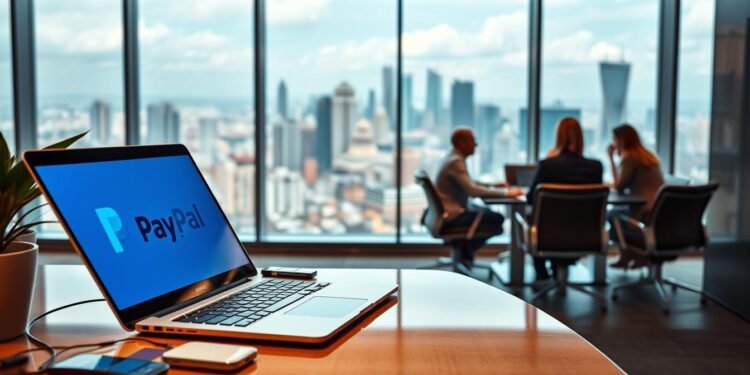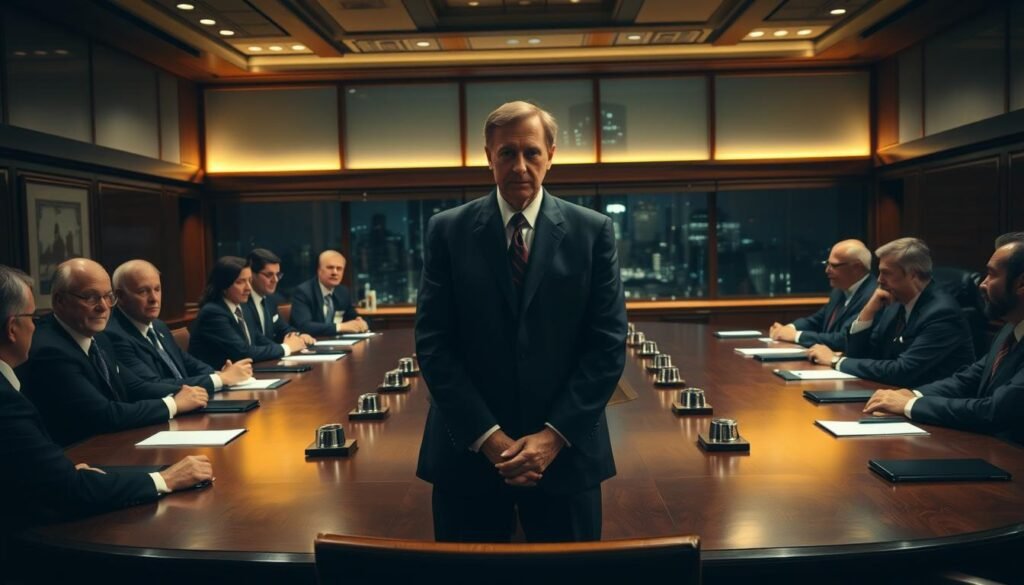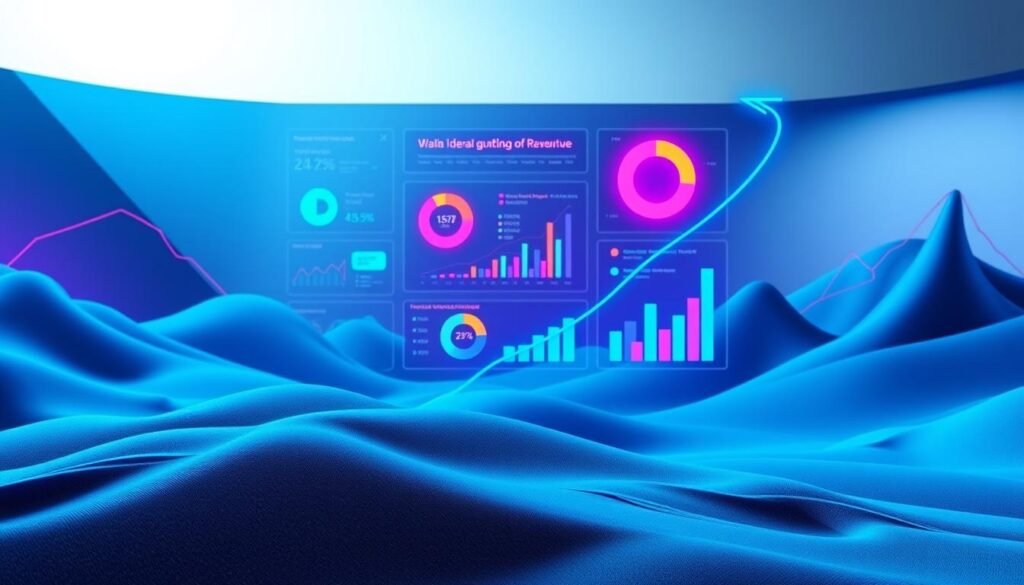What began as a small startup in 1998 has grown into a global leader in digital payments. The company, originally named Confinity, quickly evolved through strategic mergers and bold innovations. By 2000, it joined forces with X.com, laying the groundwork for what would become a fintech giant.
In 2002, eBay acquired the firm for $1.5 billion, accelerating its reach. Today, it operates in over 200 markets, supporting 25 currencies. The COVID-19 pandemic further boosted its growth, with a 78% stock surge and $220 billion in payment volume in 2020 alone.
Recent years have seen major moves, including a stablecoin launch and leadership shifts. This is the story of how a simple idea transformed the way the world handles money.
Key Takeaways
- Founded in 1998 as Confinity before merging with X.com in 2000.
- Acquired by eBay in 2002 for $1.5 billion, fueling rapid expansion.
- Operates in 200+ markets with support for 25 currencies.
- Pandemic-driven growth led to a 78% stock surge in 2020.
- Recent developments include a stablecoin launch and leadership changes.
From Confinity to X.com: The Origins of PayPal
The roots of modern digital payments trace back to two innovative startups in Silicon Valley. Confinity, founded in December 1998, initially focused on Palm Pilot security software. By 1999, Max Levchin and Peter Thiel pivoted to a digital wallet, seeing potential in email-based transactions.
Meanwhile, Elon Musk launched X.com in October 1999 with $12 million of his own funds. The platform aimed to revolutionize banking by integrating all financial services. While Confinity targeted eBay sellers, X.com dreamed of replacing traditional banks.
Max Levchin and Peter Thiel’s Vision for Confinity
Levchin’s engineering prowess and Thiel’s strategic mind drove Confinity’s early success. Their breakthrough? A system letting users send money via email—a novelty in 1999. This simple idea became the backbone of their payment system.
Elon Musk’s X.com and the Battle for Digital Payments
Musk’s X.com prioritized aggressive growth, even offering cash incentives to new users. His $25 million investment pre-merger underscored his confidence. The rivalry forced both companies to innovate faster, setting the stage for a historic merger.
The Fierce Rivalry That Shaped PayPal’s Future
Customer acquisition became the battleground for digital wallet supremacy in 2001. Both companies deployed aggressive tactics to dominate eBay’s growing marketplace, where auction payments were shifting online.
Customer Acquisition Wars on eBay
The $10 referral bonus program turned users into salespeople overnight. For every new sign-up, both senders and recipients received cash – a viral tactic that doubled competitor offers. Within months, 70% of eBay auctions accepted these payment services.
Engineering teams worked around the clock monitoring transaction patterns. Real-time data helped optimize user onboarding flows, reducing drop-offs during account setup. These improvements gave the platform a critical edge.
Strategic Moves and Sleepless Nights
Seller incentive programs proved equally crucial. Reduced fees for high-volume merchants created loyal advocates. This grassroots growth strategy outpaced traditional marketing efforts threefold.
These combined efforts ultimately convinced eBay to acquire the platform over rival Billpoint in 2002. The victory demonstrated how customer-focused innovation could outmaneuver larger competitors in emerging markets.
The Merger That Changed Everything
The digital payment landscape shifted dramatically in March 2000 when two Silicon Valley disruptors joined forces. Confinity and X.com, despite their fierce competition, recognized greater potential in unification than rivalry. This strategic alliance created a financial service powerhouse that would redefine online transactions.
Negotiating the X.com and Confinity Deal
Valuation disputes nearly derailed early talks between the companies. X.com’s $12 million investment created tension, with Musk pushing for dominant branding. Confinity’s leadership, including Peter Thiel, fought to preserve their technology’s identity.
Key negotiators faced technical hurdles during due diligence. Integrating different payment systems required compromises from both teams. Employee retention became critical as consolidation fears spread through both organizations.
Why a 50-50 Partnership Won Out
The equal stock split emerged as the only viable solution after weeks of debate. This partnership structure preserved both teams’ stakes while allowing combined operations. Thiel’s appointment as Chairman balanced Musk’s operational control.
During this time, engineers worked tirelessly to merge the platforms. The technical integration proved more challenging than financial terms. Their success laid the foundation for what would eventually become today’s global payment leader.
How PayPal Got Its Name
The summer of 2001 marked a pivotal rebranding decision that would define digital payments for decades. As the merged company sought an identity beyond X.com, marketing teams tested dozens of brand name alternatives with focus groups. Legal teams simultaneously raced to clear trademarks for the leading candidates.
The Debate Over X-PayPal Branding
Internal factions clashed over whether to keep the X.com heritage. Engineers favored continuity, while marketers pushed for a fresh start. The compromise “X-PayPal” hybrid lasted just months before consumer testing revealed overwhelming preference for the simpler option.
Transitioning the entire website from X.com infrastructure required meticulous planning. Engineers rebuilt payment processing systems while maintaining uninterrupted service. The $1 million domain acquisition of PayPal.com proved critical for both branding and search visibility.
The Product That Outshined the Parent Company
Merchants had already begun referring to payments as “PayPal” regardless of the official branding. This organic adoption convinced leadership to fully embrace the name. By June 2001, the flagship product became the company’s identity.
Success metrics validated the decision. Daily transactions surpassed 1 million within a year of rebranding. The keyword-rich domain name boosted organic search rankings, while the memorable branding accelerated word-of-mouth growth among eBay sellers and beyond.
Leadership Turmoil and the Rise of Peter Thiel
Executive tensions reached a boiling point during a critical growth phase. The merged company faced fundamental disagreements about its strategic direction, pitting technical vision against operational execution.
Elon Musk’s Brief Tenure as CEO
Musk assumed the CEO position in 2000 with ambitious plans to transform X.com into a financial hub. His focus on long-term technical development clashed with immediate profitability needs.
Employee morale fluctuated as priorities shifted weekly. Engineers praised Musk’s innovative thinking, while operations teams struggled with unclear directives. This disconnect became unsustainable after nine months.
The Coup That Brought Thiel to Power
Board members orchestrated a restructuring in late 2000 that elevated Peter Thiel. His financial acumen and steady leadership style addressed growing concerns about cash burn.
Thiel’s first moves included cutting non-essential projects and refocusing on core payment services. These changes stabilized operations but slowed some innovation pipelines.
The transition offered valuable lessons in founder succession planning. Clear communication about leadership changes proved as important as the technical role each executive played in the company’s evolution.
PayPal’s Battle Against Fraud
Early digital payments faced a critical challenge that threatened their very existence. Fraudsters quickly adapted to exploit vulnerabilities in emerging financial systems, with some scams draining entire accounts. The company’s survival depended on building better defenses than the criminals’ offenses.
Max Levchin’s Engineering Triumphs
The young CTO developed revolutionary tools to combat financial crime. His team created machine learning models that detected suspicious patterns in milliseconds. Their real-time monitoring flagged 90% of fraudulent transactions before completion.
A $169 million acquisition of Fraud Sciences in 2008 brought advanced risk algorithms. These technologies became industry standards, protecting millions of users worldwide. Law enforcement partnerships helped track international crime rings exploiting payment platforms.
How CAPTCHA Became a Global Standard
The 2001 patent for distorted character recognition changed online security forever. This simple test blocked automated attacks while maintaining human access. Google later adopted the technology for its widespread protection needs.
Open-sourcing the algorithms accelerated their global adoption. What began as a PayPal defense mechanism now secures billions of logins daily. This innovation marked a rare case where financial success directly improved internet safety for all users.
The eBay Acquisition: A $1.5 Billion Gamble
July 2002 saw one of Silicon Valley’s most strategic acquisitions unfold. eBay’s purchase of the payment platform for $1.5 billion came just months after its successful IPO at $13 per share. The deal would transform both companies’ trajectories in the e-commerce market.
Why eBay Bet Big on PayPal
Integration teams faced immediate technical hurdles merging systems. eBay’s legacy infrastructure required extensive modifications to handle real-time payment processing. Merchant education programs helped sellers adapt to the new financial tools.
The acquisition proved its worth through improved transaction success rates. Cross-border capabilities allowed eBay to accelerate international expansion. By 2012, the payment service contributed 40% of eBay’s total revenue.
Becoming the Default Payment Method
Standardization across eBay’s marketplace created seamless buyer experiences. The unified system reduced checkout friction and boosted conversion rates. Sellers benefited from faster settlement times and simplified accounting.
Strategic partnerships with financial institutions expanded service offerings. These moves cemented the platform’s position as the preferred online payment solution. What began as a gamble became one of tech’s most successful mergers.
Expanding Beyond eBay: PayPal’s Growth Phase
Breaking free from its eBay dependency marked a turning point for the digital payment giant. The company shifted focus to small businesses and physical retail, unlocking new revenue streams. By 2012, its payment volume hit $145 billion, proving the strategy’s success.
Launching PayPal Here for Small Businesses
The 2012 rollout of PayPal Here targeted mom-and-pop shops with an EMV chip card reader. Simplified API documentation helped developers integrate payment services seamlessly. PCI compliance certification ensured security for small business customers.
Retailer incentive programs boosted adoption, offering discounted transaction fees. Multi-currency support attracted global merchants, cementing its role beyond online auctions.
The Discover Card Partnership
A landmark 2012 deal with Discover opened 7 million retail locations. Cross-promotions, like cashback rewards, drove user engagement. This move accelerated the platform’s offline growth, bridging digital and physical commerce.
Key Acquisitions That Fueled Innovation
Strategic acquisitions became the driving force behind the company’s evolution. Each deal targeted specific gaps in the market, from mobile payments to retail analytics. These moves transformed the platform into a versatile financial product.
Braintree and Venmo: Mastering Mobile Payments
The 2013 $800 million acquisition of Braintree solved a critical need. Its seamless SDKs allowed businesses to integrate payments into apps effortlessly. Venmo’s social features were later merged, creating a viral peer-to-peer network.
Mobile transaction volume tripled within two years. Developers praised the simplified API documentation, which reduced integration time by 70%. This purchase proved essential for capturing younger users.
The $4 Billion Honey Deal
Honey’s 2019 acquisition brought advanced coupon technology. Its data analytics helped merchants optimize pricing and promotions. The deal also expanded the platform’s reach into e-commerce browsing behavior.
Regulatory approvals for fintech mergers faced scrutiny but ultimately passed. Honey’s 17 million users gained instant payment options, boosting engagement. This strategy highlighted the value of complementary services.
Later purchases like Paidy ($2.7B) further diversified offerings. Each integration followed a clear pattern: identify, acquire, and enhance. The results speak in billions of processed transactions yearly.
The Spin-Off: PayPal Regains Independence
A bold corporate move in 2015 reshaped the financial technology landscape. After years under eBay’s umbrella, the payment giant prepared to stand alone. Shareholders approved the separation, unlocking new potential for the company.
Carl Icahn’s Role in the Split
Activist investor Carl Icahn played a crucial role in pushing for independence. His advocacy highlighted the untapped value of separating from eBay. The move aimed to streamline operations and boost revenue growth.
Relisting on Nasdaq as PYPL
The company debuted on Nasdaq with a $46 billion market cap. PYPL stock surged 5% on its first trading day. Investors welcomed the clarity of a standalone financial structure.
Post-spinoff, a hiring spree strengthened its leadership team. Brand differentiation from eBay became a top priority. The transition marked a fresh start for the digital payment pioneer.
PayPal’s Global Expansion Strategy
Global ambitions took center stage as the payment platform set its sights beyond U.S. borders. By 2000, strategic teams implemented simultaneous launches across 26 countries, adapting to diverse financial regulations. This push generated 15% of total revenue from international markets within just twelve months.
Breaking Into 26 Countries in One Year
Localization specialists redesigned interfaces for language and payment preferences in each region. The EU required strict compliance with payment directives, prompting legal teams to work overtime. Partnerships with major banks like Deutsche Bank and HSBC provided local transaction processing.
Multi-Currency Transactions and Market Dominance
Support for 25 currency types eliminated conversion headaches for cross-border shoppers. Advanced hedging strategies protected against exchange rate fluctuations. These financial services gave merchants confidence to expand internationally with lower risk.
The platform’s infrastructure scaled to handle new transaction volumes without delays. Regional offices in London, Singapore, and Sydney managed localized customer support. This groundwork positioned the company for sustained global leadership in digital payments.
PayPal Credit: Revolutionizing Online Lending
Digital lending took center stage with PayPal’s $945 million purchase of Bill Me Later in 2008. This move expanded its financial services beyond payments, offering buyers flexible credit options at checkout. The rebrand to PayPal Credit in 2014 unified the service under its trusted brand.
From Bill Me Later to a Full Financial Service
Bill Me Later’s technology streamlined approvals using advanced risk models. Buyers could defer payments, while merchants gained higher conversion rates. Integration with PayPal accounts made it seamless for 200 million users.
The platform offered lines of credit up to $10,000 with 19.99% APR. Algorithms adjusted limits based on spending habits and repayment history. Over time, it became a staple for e-commerce financing.
Regulatory Challenges and the $25 Million Fine
In 2015, the CFPB fined PayPal Credit $25 million for deceptive practices. Issues included unclear promotional terms and unauthorized credit lines. The settlement mandated clearer disclosures and refunds to affected users.
State licensing requirements added complexity. Compliance costs soared, but stricter oversight improved consumer trust. Today, PayPal Credit remains a key player in digital lending.
Embracing Cryptocurrency: PayPal’s Bold Move
The financial world watched closely as PayPal made its most daring pivot yet. In October 2020, the platform secured a New York DFS license to offer crypto trading, becoming the first major payment firm to do so. Users gained instant access to Bitcoin, Ethereum, and other digital assets, bridging traditional finance and blockchain.
The 2020 Cryptocurrency Integration Announcement
Behind the scenes, engineers built a robust system to handle volatility and security risks. Partnerships with Paxos Trust provided blockchain infrastructure, while cold storage protocols safeguarded assets. Merchant education programs helped businesses navigate tax implications and customer demand.
PayPal USD Stablecoin and SEC Scrutiny
The 2023 launch of PYUSD stablecoin marked another milestone in PayPal’s development. Backed 1:1 by U.S. dollar reserves, it aimed to simplify crypto payments. However, the SEC opened an investigation months later, questioning its classification as a security.
Regulatory lobbying intensified as policymakers debated oversight frameworks. Despite challenges, PayPal’s crypto ventures demonstrated how legacy fintech could innovate while managing risk. The moves positioned the company at the forefront of digital currency adoption.
Leadership Transitions: From Schulman to Chriss
2023 marked a pivotal leadership shift for the digital payment giant as it navigated economic headwinds. Dan Schulman stepped down after nearly a decade of steering the company through rapid expansion. His departure coincided with a 7% workforce reduction aimed at streamlining operations.
Dan Schulman’s Legacy and Layoffs
Schulman’s tenure saw revenue climb to $29.77 billion in 2023. He championed financial inclusion initiatives and cryptocurrency integration. However, rising costs prompted difficult decisions about the company’s strategy.
The layoffs affected approximately 2,000 employees across multiple divisions. Generous severance packages helped ease the transition. This restructuring aimed to save $1.3 billion annually while maintaining growth potential.
Alex Chriss’s Vision for the Future
The board selected Intuit veteran Alex Chriss as the new CEO in September 2023. His background in small business solutions aligns with the company’s merchant-focused direction. Immediate priorities included AI integration and cost discipline.
Chriss outlined ambitious plans to enhance checkout experiences and payment security. His role involves balancing innovation with profitability targets. Early initiatives focused on simplifying developer tools and expanding B2B services.
Investors await tangible results from this leadership transition. The coming years will test whether fresh perspectives can reignite the company’s competitive edge in digital payments.
PayPal’s Financial Evolution: By the Numbers
Financial metrics reveal the true scale of PayPal’s market dominance over the past decade. The company transformed from an eBay subsidiary to a standalone financial giant, with revenue growing nearly tenfold since 2012. Key performance indicators highlight both steady growth and pandemic-driven spikes.
Tracking the Revenue Growth Curve
From 2012 to 2023, annual revenue surged from $5.6 billion to $29.77 billion. The most dramatic jump occurred in 2020, when COVID-19 lockdowns boosted digital payment adoption by 22%. Each subsequent year maintained this elevated baseline, proving the shift wasn’t temporary.
Operating margins tell another success story. Despite rising costs, PayPal maintained 15-18% margins through strategic stock buybacks. These programs returned $5 billion to shareholders between 2015-2020 alone.
Pandemic Effects on Digital Adoption
The health crisis brought 72 million new users in 2020 alone. Buy Now, Pay Later services contributed significantly, generating $1.5 billion in revenue by 2023. Merchant adoption rates tripled as small businesses sought contactless solutions.
User acquisition costs dropped 40% during this period. The platform’s established trust made it the default choice for first-time digital payment users. This advantage solidified PayPal’s market leadership position.
Conclusion: PayPal’s Enduring Impact on Fintech
The fintech revolution found its champion through relentless innovation and strategic vision. This company democratized financial services by empowering SMEs with tools like instant lending and multi-currency support. Its fraud prevention systems became industry gold standards, while mobile UX innovations set benchmarks for seamless payments.
Ranked #143 on Fortune 500 in 2022, its influence spans open banking initiatives and cryptocurrency adoption. Membership in the MACH Alliance underscores its commitment to cutting-edge technology. From small online sellers to global merchants, the platform reshaped how money moves.
Today, its legacy lives in every secure digital transaction. The success proves that solving real-world problems with technology creates lasting change. Fintech’s future still builds on these foundational advances.
FAQ
Who were the founders behind PayPal’s early development?
Max Levchin and Peter Thiel launched Confinity, which later merged with Elon Musk’s X.com to form the foundation of the payment system.
How did PayPal gain traction in its early days?
The company aggressively acquired users by offering incentives, especially on eBay, where it became the preferred payment method for auctions.
Why did X.com and Confinity merge?
Both companies were competing fiercely in digital payments. A 50-50 merger allowed them to combine resources and dominate the market faster.
What led to the name change from X.com to PayPal?
The brand was more recognizable than its parent company, leading to a full rebrand to focus on financial services.
How did PayPal combat fraud in its early stages?
Max Levchin developed tools like CAPTCHA and advanced fraud detection algorithms to secure transactions.
Why did eBay acquire PayPal for
FAQ
Who were the founders behind PayPal’s early development?
Max Levchin and Peter Thiel launched Confinity, which later merged with Elon Musk’s X.com to form the foundation of the payment system.
How did PayPal gain traction in its early days?
The company aggressively acquired users by offering incentives, especially on eBay, where it became the preferred payment method for auctions.
Why did X.com and Confinity merge?
Both companies were competing fiercely in digital payments. A 50-50 merger allowed them to combine resources and dominate the market faster.
What led to the name change from X.com to PayPal?
The brand was more recognizable than its parent company, leading to a full rebrand to focus on financial services.
How did PayPal combat fraud in its early stages?
Max Levchin developed tools like CAPTCHA and advanced fraud detection algorithms to secure transactions.
Why did eBay acquire PayPal for $1.5 billion?
The platform was already handling most eBay transactions, making the acquisition a strategic move to streamline payments.
What role did Carl Icahn play in PayPal’s independence?
He pushed for the spin-off from eBay, leading to PayPal relisting as PYPL on Nasdaq in 2015.
How did PayPal expand globally so quickly?
The company launched in 26 countries within a year, leveraging partnerships and multi-currency support to grow its user base.
When did PayPal embrace cryptocurrency?
In 2020, it announced support for Bitcoin and later launched its own stablecoin, PayPal USD.
What was Dan Schulman’s impact as CEO?
He led significant revenue growth, expanded financial services, and navigated challenges like pandemic-driven demand.
Who were the founders behind PayPal’s early development?
Max Levchin and Peter Thiel launched Confinity, which later merged with Elon Musk’s X.com to form the foundation of the payment system.
How did PayPal gain traction in its early days?
The company aggressively acquired users by offering incentives, especially on eBay, where it became the preferred payment method for auctions.
Why did X.com and Confinity merge?
Both companies were competing fiercely in digital payments. A 50-50 merger allowed them to combine resources and dominate the market faster.
What led to the name change from X.com to PayPal?
The brand was more recognizable than its parent company, leading to a full rebrand to focus on financial services.
How did PayPal combat fraud in its early stages?
Max Levchin developed tools like CAPTCHA and advanced fraud detection algorithms to secure transactions.
Why did eBay acquire PayPal for $1.5 billion?
The platform was already handling most eBay transactions, making the acquisition a strategic move to streamline payments.
What role did Carl Icahn play in PayPal’s independence?
He pushed for the spin-off from eBay, leading to PayPal relisting as PYPL on Nasdaq in 2015.
How did PayPal expand globally so quickly?
The company launched in 26 countries within a year, leveraging partnerships and multi-currency support to grow its user base.
When did PayPal embrace cryptocurrency?
In 2020, it announced support for Bitcoin and later launched its own stablecoin, PayPal USD.
What was Dan Schulman’s impact as CEO?
He led significant revenue growth, expanded financial services, and navigated challenges like pandemic-driven demand.
.5 billion?
The platform was already handling most eBay transactions, making the acquisition a strategic move to streamline payments.
What role did Carl Icahn play in PayPal’s independence?
He pushed for the spin-off from eBay, leading to PayPal relisting as PYPL on Nasdaq in 2015.
How did PayPal expand globally so quickly?
The company launched in 26 countries within a year, leveraging partnerships and multi-currency support to grow its user base.
When did PayPal embrace cryptocurrency?
In 2020, it announced support for Bitcoin and later launched its own stablecoin, PayPal USD.
What was Dan Schulman’s impact as CEO?
He led significant revenue growth, expanded financial services, and navigated challenges like pandemic-driven demand.










